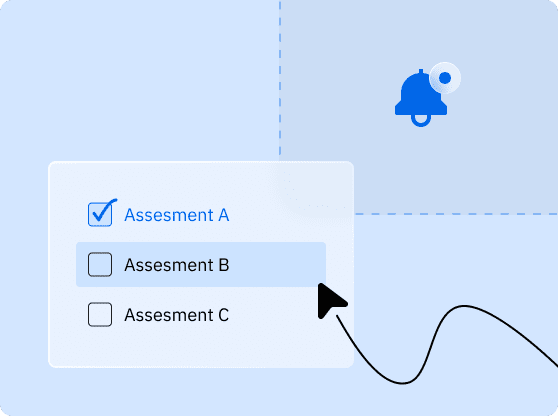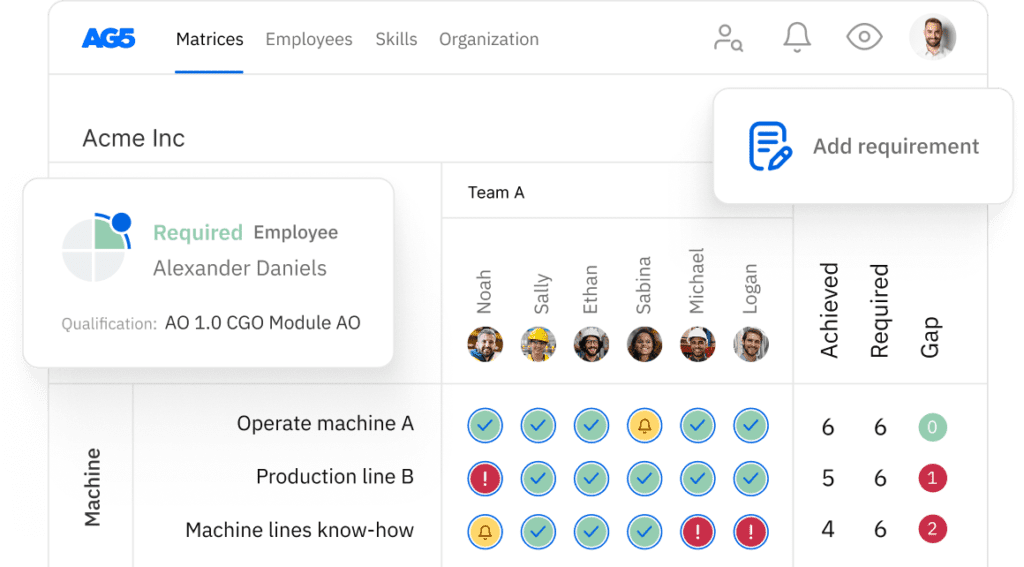What’s the difference between knowledge and skills?
What is the difference between knowledge and skills? This article will explain the difference between these two terms and discuss several effective methods to develop both.

Knowledge and skills are two of the main factors that determine an employee’s competence in a certain area or field. They’re also huge drivers of organizational success. However, the two terms are often used interchangeably, despite their differences.
In this article, we’ll take a deep dive into the difference between “knowledge” and “skills”, discuss several effective methods to develop both, and explore how AG5 can help you measure and track them.
What’s the difference between knowledge and skills?Copied
Knowledge and skills are closely related yet distinct concepts. In an industrial setting, this distinction is particularly important.
For example, an employee might possess extensive knowledge of machine operations, including safety protocols and maintenance procedures, but without hands-on experience, they may struggle to operate the machinery efficiently.
On the other hand, a skilled machine operator might lack deep theoretical knowledge, but can still competently operate machinery.
The ideal balance combines both: knowledge to understand best practices and skills to apply them in real-world scenarios. In the following sections, we’ll dive deeper into these concepts.
The definition of knowledge
Knowledge is what you know. It is largely theoretical in nature, and involves retaining information about topics learned through formal education, industry training programs, manuals and guidelines, as well as from experienced colleagues and continuous professional development.
In the manufacturing industry, knowledge could refer to the understanding of processes, machinery, production methods, quality standards, or safety regulations.
Examples of industrial knowledge include:
- Knowing how a CNC machine operates
- Understanding Lean Manufacturing principles
- Familiarization with Six Sigma methodologies
- Knowing the properties of different materials used in production
The definition of skills
Skills are what you can do. They refer to the hands-on ability to perform certain tasks or jobs. Typically, skills are obtained and developed through practical experience, on-the-job training, apprenticeships, and continuous practice – in other words, doing actual work and getting feedback.
Examples of industrial skills include:
- Operating a CNC machine
- Welding components
- Assembling parts on a production line
- Performing maintenance on equipment
- Conducting quality inspections
- Programming robots or machines for automated tasks
Together with aptitude, skills and knowledge form “competence”. In this way – and although they are different concepts – skills and knowledge rely on one another. For example, knowledge provides an individual with the knowledge he or she needs to design and manage a manufacturing system, while skills enable that person to effectively and efficiently operate it.
How to increase your knowledge and skillsCopied
The methods with which you can increase – or acquire new – knowledge and skills will vary, depending on what you are developing.
However, it’s important to note that because they are so closely linked, these methods are often beneficial to increasing both knowledge and skills simultaneously.
Increasing knowledge
To encourage the increase of knowledge over skills, your focus should be more on theoretical methods of learning. Here are a few examples:
Digital learning programs
To build knowledge, McKinsey recommends digital learning programs – such as online courses and webinars – that help employees stay up to date with industry trends, new technologies, and changing regulatory standards. [1]
The knowledge they acquire in these programs will help instill a culture of continuous learning, and lay the foundation upon which employees can hone new skills.
Industry 4.0 technologies
Adopting Industry 4.0 technologies like IoT, AI, and advanced analytics in the workplace. Employees can enhance or acquire new knowledge with the real-time data and insights these technologies are designed to provide.
For example, another McKinsey study shows that Industry 4.0 systems such as enterprise manufacturing intelligence (EMI) can improve decision-making and operational efficiency using data from IoT sensors. [2]
Mentorship and knowledge sharing
Mentorship or knowledge-sharing programs that see experienced employees share their expertise with those who are new to the company or industry, or less experienced, is a very efficient and effect method of increasing knowledge.
These programs help preserve and pass on valuable insights and practical knowledge that might not be fully captured in formal training programs.
Increasing skills
To place a focus on increasing skills, you should look to learning methods that are fundamentally hands-on. Here are a few examples:
Practical training or simulations
Practical, hands-on training sessions and simulations are extremely effective at increasing technical skills. Deloitte suggests that immersive training technologies, like augmented reality (AR), can provide workers with a realistic practice environment, improving their technical proficiency without the risk of real-world consequences. [3]
Agile methodologies
Agile methodologies allow employees to quickly adapt to changes, iterate on processes to refine them, and continuously improve through real-time feedback. This is an excellent way of increasing or developing skills, as the iterative project cycles in agile methodologies offer plenty of hands-on opportunities for employees.
However, the effectiveness of agile methodologies hinge on knowledge sharing and cooperation, according to a Gallup study. [4] This further hammers home the synergistic relationship between knowledge and skills.
Cross-training and job rotation
Cross-training initiative or job rotation schedules, in which employees move between various roles or tasks while at work, help ensure that employees can play more than one part on a team, department, or organization. It’s also a huge driver of skill development and acquirement.
Additionally, EY suggests that cross-training or job rotation is essential to maintaining productive during staff shortages or turnover. [5]
How can you measure knowledge vs. skills?Copied
As with developing or acquiring new knowledge and skills, the ways you measure them can differ. In this section, we’ll take a look at effective methods of measuring knowledge and skills.
Measuring knowledge
Here are a few ways to measure knowledge.
Certification and testing
You can assess knowledge through formal, classroom certification programs and periodic testing. It may even be mandatory for employees to pass exams that prove their understanding of industry standards and technological advancements.
Peer reviews and feedback
Allowing employees to evaluate each other’s understanding and application of knowledge in real-world scenarios drives collaboration and cooperation in the workplace – and also helps teams or departments quickly identify areas in which there are gaps in knowledge that should be addressed.
Measuring skill
Here are a few ways to measure skills.
Performance metrics
You can use key performance indicators (KPIs) related to job performance to measure skills. Common KPIs for skills measurement include machine downtime, product quality, and production rates – all of which are important factors in indicating an employees’ proficiency in their role.
Practical assessments
Conducting hands-on, practical assessments, in which employees demonstrate their skills in a controlled environment, is another great way to measure skill level. Thinking industrially, practical assessments might focus on operating or repairing machinery or executing specific manufacturing processes, like injection molding.
Continuous monitoring and feedback
Regular monitoring and providing feedback on day-to-day performance help measure and improve skills. For example, real-time data from digital performance management systems can provide insights into how effectively employees are applying their skills.
Managing your employees’ knowledge and skills with AG5Copied
Finding skills gaps in your business
AG5 helps organizations identify and close skill gaps – areas where employees may lack the necessary skills or knowledge to meet job requirements.
By analyzing the skills competencies employees have against industry standards or other benchmarks, you can proactively plan training programs, upskilling initiatives, and workforce development strategies.
Additionally, with real-time insights into proficiency levels, AG5 helps businesses ensure they have the right talent in place to meet evolving industry demands.
AG5’s skills management software encompasses both knowledge and skills in your organization. You can use it to track completed trainings and courses, monitor certification statuses so they don’t expire, analyze and measure proficiency levels for all the roles and jobs in your organization, and more.
You can also use AG5 to:
- Map the skills, knowledge, and competences present in your organization – as well as those your employees need
- Replicate complex organizational structures with drag-and-drop menus
- Find the best replacements for employees off sick in a single search
- Enter updates and training results from the shop floor in real time
- Match projects to specific employees’ expertise and experience
Want to see how this would work in your organization? Schedule a free, live, 15-minute demo for a customized look at AG5 in action.
FAQs Copied
-
Why are knowledge and skills both important?
-
Can you have knowledge without skills (or vice versa)?
-
Is knowledge or skills harder to teach?
-
Is knowledge or skills more valuable in industry?
-
Do knowledge and skills evolve over time?
Sources Copied
- Change view: Table
-
APA
| # | Source title | Description | Publication | Retrieved | Source URL |
|---|---|---|---|---|---|
| 1 | Implementing a digital transformation at industrial companies | McKinsey & Company | - | July 4, 2024 | .. |
| 2 | The next horizon for industrial manufacturing: Adopting disruptive digital technologies in making and delivering | McKinsey Digital | - | July 4, 2024 | .. |
| 3 | A new approach to soft skill development | Deloitte Insights | - | July 4, 2024 | .. |
| 4 | Cooperation Is Key to an Agile Workplace | Gallup | - | July 4, 2024 | .. |
| 5 | How adaptive skills can play a pivotal role in building the manufacturing sector of the future | Ey | - | July 4, 2024 | .. |
Author Copied
Revisions Copied
Added new sections and elaborated FAQ answers.
Written by: Rick van Echtelt
Technically reviewed by: Adam Kohut
Added two new sections (“How to increase your knowledge and skills” and “Measuring knowledge vs. skills”) added FAQ, added sourced content, rewrote existing content.
Written by: Rick van Echtelt
Technically reviewed by: Adam Kohut

